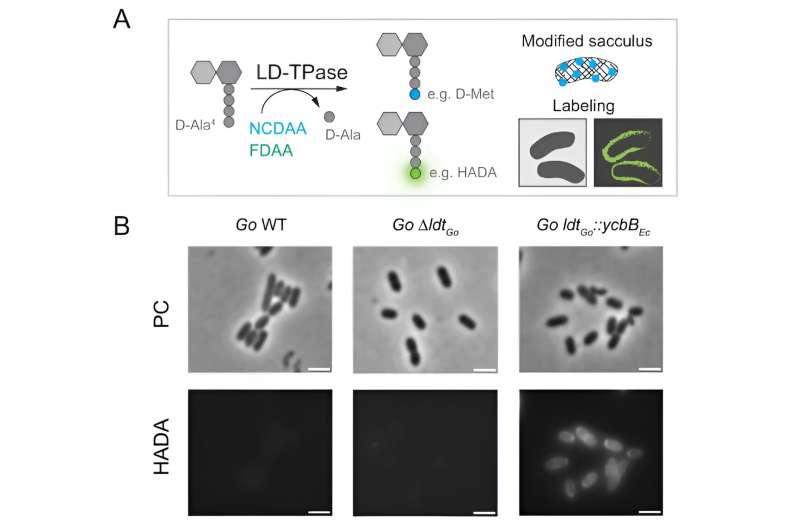This article has been reviewed according to Science X's editorial process and policies. Editors have highlighted the following attributes while ensuring the content's credibility:
fact-checked
trusted source
proofread
Discovery of new enzymes related to bacterial cell walls could lead to novel antibiotics

Researchers at Umeå University in Sweden, led by Professor Felipe Cava, have identified a new family of enzymes that creates a unique type of cross-linking between the building blocks of bacterial cell walls. This discovery could help develop new antibiotics against infectious diseases.
Bacterial cell walls form mesh-like structures, shielding cells from rupturing under high internal pressure and safeguarding against external threats. The cell wall is comprised of sugar and amino acid molecules interconnected by various types of cross-links. These cross-links play a crucial role in providing strength and stability to the cell wall, while also enabling bacteria to adapt to diverse environments and stressors.
In a study recently published in Nature Communications, researchers from Umeå University and international institutions have unveiled a novel family of enzymes responsible for generating a unique cross-linkage between L-alanine and meso-diaminopimelic acid.
These amino acids are integral components of the peptide chains constituting the cell wall of numerous bacterial species. Termed LD1,3-transpeptidase, this enzyme has been identified across various groups of alpha and beta proteobacteria, including opportunistic pathogens such as Burkholderia and Achromobacter.
The researchers utilized Gluconobacter oxydans, a model organism employed in vinegar production, to identify the novel LD1,3-transpeptidase enzyme and elucidate its three-dimensional structure. They have demonstrated that this enzyme possesses unique characteristics distinguishing it from other known enzymes involved in cell wall cross-linkage. These distinctive properties enable the enzyme to utilize various substrates and execute diverse reactions, critical for maintaining the cell wall's integrity.
Specifically, their findings indicate that cells lacking these cross-links exhibit heightened sensitivity to β-lactam antibiotics, underscoring the potential of LD1,3-transpeptidases as promising targets for therapeutic interventions, particularly those aimed at enhancing antibiotic effectiveness.
The principal investigator of the study is Felipe Cava, Professor of Infection Biology at Umeå University and Director of the Umeå Hypoxic Research Facility. With extensive expertise in bacterial cell wall research and its implications in bacterial survival and disease progression, Professor Cava has spearheaded investigations into this field for a significant duration.
"The bacterial cell wall stands as one of the most remarkable structures, yet much remains to be uncovered about its diversity and dynamics. Through the identification and characterization of novel enzyme families like LD1,3-transpeptidase, we not only expand our understanding of bacterial biology but also discover fresh targets for developing antibiotics to combat infectious diseases" says Felipe Cava.
More information: Akbar Espaillat et al, A distinctive family of L,D-transpeptidases catalyzing L-Ala-mDAP crosslinks in Alpha- and Betaproteobacteria, Nature Communications (2024). DOI: 10.1038/s41467-024-45620-5
Provided by Umea University




















